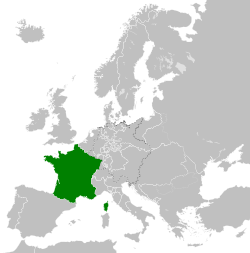Bourbon Dynasty, Restored
| Kingdom of France | ||||||||||
| Royaume de France | ||||||||||
|
||||||||||
|
||||||||||
|
Motto Montjoie Saint Denis! "Mountjoy Saint Denis!" |
||||||||||
|
Anthem Le Retour des Princes français à Paris "The Return of the French Princes to Paris" |
||||||||||
|
The Kingdom of France in 1815
|
||||||||||
| Capital | Paris | |||||||||
| Languages | French | |||||||||
| Religion | Roman Catholic | |||||||||
| Government | Constitutional monarchy | |||||||||
| King | ||||||||||
| • | 1814–1815, 1815-1824 | Louis XVIII | ||||||||
| • | 1824–1830 | Charles X | ||||||||
| • | 1830 (de jure) | Louis XIX | ||||||||
| • | 1830 (de jure) | Henry V | ||||||||
| Prime Minister | ||||||||||
| • | 1815 | Charles de Bénévent (first) | ||||||||
| • | 1829–1830 | Jules de Polignac (last) | ||||||||
| Legislature | Parliament | |||||||||
| • | Upper house | Chamber of Peers | ||||||||
| • | Lower house | Chamber of Deputies | ||||||||
| History | ||||||||||
| • | Restoration | 6 April 1814 | ||||||||
| • | Treaty of Paris | 30 May 1814 | ||||||||
| • | Constitution adopted | 4 June 1814 | ||||||||
| • | Hundred Days | 20 Mar – 7 Jul 1815 | ||||||||
| • | Invasion of Spain | 6 April 1823 | ||||||||
| • | July Revolution | 26 July 1830 | ||||||||
| Area | ||||||||||
| • | 1815 | 560,000 km² (216,217 sq mi) | ||||||||
| Currency | French franc | |||||||||
|
||||||||||
The Bourbon Restoration was the period of French history following the fall of Napoleon in 1814 until the July Revolution of 1830. The brothers of executed Louis XVI of France reigned in highly conservative fashion, and the exiles returned. They were nonetheless unable to reverse most of the changes made by the French Revolution and Napoleon. At the Congress of Vienna they were treated respectfully, but had to give up all the territorial gains made since 1789.
King Louis XVI of the House of Bourbon had been overthrown and executed during the French Revolution (1789–1799), which in turn was followed by Napoleon as ruler of France. A coalition of European powers defeated Napoleon in the War of the Sixth Coalition, ended the First Empire in 1814, and restored the monarchy to the brothers of Louis XVI. The Bourbon Restoration lasted from (about) 6 April 1814 until the popular uprisings of the July Revolution of 1830. There was an interlude in spring 1815—the "Hundred Days"—when the return of Napoleon forced the Bourbons to flee France. When Napoleon was again defeated they returned to power in July.
During the Restoration, the new Bourbon regime was a constitutional monarchy, unlike the absolutist Ancien Régime, and so it had some limits on its power. The period was characterized by a sharp conservative reaction, and consequent minor but consistent occurrences of civil unrest and disturbances. It also saw the reestablishment of the Catholic Church as a major power in French politics.
The eras of the French Revolution and Napoleon brought a series of major changes to France which the Bourbon Restoration did not reverse. First of all, France became highly centralized, with all decisions made in Paris. The political geography was completely reorganized and made uniform. France was divided into more than 80 departments, which have endured into the 21st century. Each department had an identical administrative structure, and was tightly controlled by a prefect appointed by Paris. The complex multiple overlapping legal jurisdictions of the old regime had all been abolished, and there was now one standardized legal code, administered by judges appointed by Paris, and supported by police under national control. The Catholic Church lost all its lands and buildings during the Revolution, and these were sold off or came under the control of local governments. The bishop still ruled his diocese (which was aligned with the new department boundaries), and communicated with the pope through the government in Paris. Bishops, priests, nuns and other religious people were paid salaries by the state. All the old religious rites and ceremonies were retained, and the government maintained the religious buildings. The Church was allowed to operate its own seminaries and to some extent local schools as well, although this became a central political issue into the 20th century. Bishops were much less powerful than before, and had no political voice. However, the Catholic Church reinvented itself and put a new emphasis on personal religiosity that gave it a hold on the psychology of the faithful. Education was centralized, with the Grand Master of the University of France controlling every element of the entire educational system from Paris. New technical universities were opened in Paris which to this day have a critical role in training the elite.
...
Wikipedia



